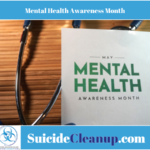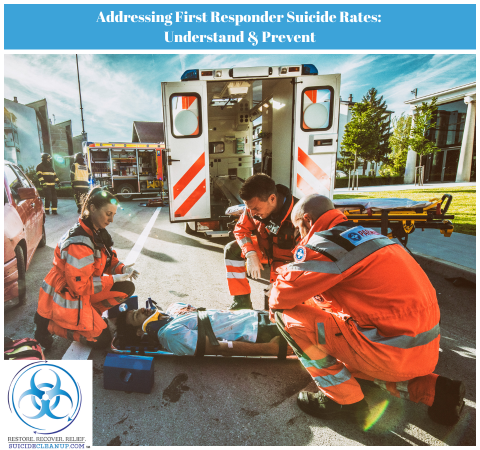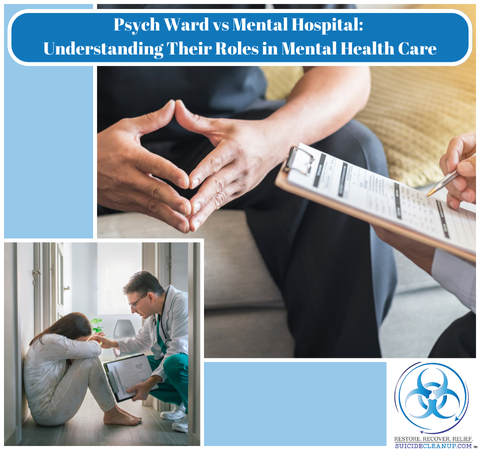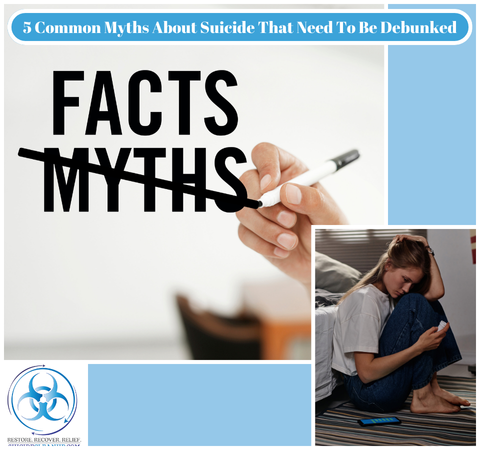
The Future of Mental Health: Technology’s Role in Preventing Suicide
March 21, 2024
Mental Health Awareness Month: The Role of Suicide Cleanup in Healing
May 30, 2024First responders play a very vital role in our society often going unrecognized until they are needed. These men and women put their lives on the line responding to emergencies and ensuring our public safety and health. First responders include law enforcement officers (LEOs), firefighters, emergency medical services (EMS) and public safety telecommunicators. When we consider the nature of these professions it becomes obvious that they are faced with unique stressors that leave them at a higher risk of taking their own lives. According to findings from the National Violent Death Reporting System, first responder suicide rates are higher when compared to non first responder occupations. In this article we are going to cover the topic of first responder suicide rates going over the statistics, potential solutions to the problem as well as the need for more research and data.
Read our post on Law Enforcement Suicide Statistics to learn more specifically about suicide as it pertains to law enforcement officers.
The Harsh Realities of First Responder Suicide Rates
Here are some important takeaways from the research:
- Data from the NVDRS shows that first responders accounted for 1% of all suicides between 2015 and 2017.
- When examining the breakdown by response discipline, these suicides occurred among law enforcement officers (58%), firefighters (21%), EMS providers (18%), and public safety telecommunicators (2%).
- A higher percentage of first responders used a firearm as the method of injury when compared to non-first responders (69% versus 44%).
- Some common risk factors for suicide among the general population (history of suicidal thoughts, previous suicide attempt, substance use disorder) were significantly lower among first responders.
Data from other research:
- An analysis of state death registry data in Arizona revealed that the odds of EMTs dying by suicide were 1.39 times greater than that of the general adult population.
- An Australian retrospective mortality analysis found that emergency and protective services workers had higher age-adjusted suicide rates than workers in other occupations.
- Emergency & Protective Services: 22.4 per 100,000 for males and 7.8 for females
- Other Occupations: 15.5 per 100,000 for males and 3.4 for females
- In 2021 data from the National Occupational Mortality Surveillance System (NOMSS) showed that fire fighters and EMTs had a higher chance of dying from suicide than the rest of the working population in the United States.
- Another recent analysis of NOMSS data revealed that LEOs were 54% more likely to die of suicide than all decedents with a reported occupation.
- A paper by Clinical Psychology Review conducts a systematic review of studies on suicidal thoughts and behaviors among LEOs, FFs, and EMS clinicians. The paper found higher rates of reported suicidal thoughts and suicide attempts among these workers, compared to the general population.
The Unique Challenges and Stresses Faced by First Responders
 As we discussed earlier the nature of the job puts first responders at a higher risk of suicide. Let’s examine some of the unique challenges that come into play when address first responder suicides.
As we discussed earlier the nature of the job puts first responders at a higher risk of suicide. Let’s examine some of the unique challenges that come into play when address first responder suicides.
- Trauma: One of the primary challenges faced by first responders is the exposure to trauma. They are frequently confronted with scenes of violence, accidents, and human suffering, which can be deeply disturbing and emotionally draining. This constant exposure can lead to PTSD, a condition characterized by intrusive thoughts, flashbacks, and heightened anxiety.
- Demands of the job: In addition to trauma, first responders also face the stress of working long hours, often under intense pressure and with limited resources. The demands of the job can lead to burnout, a state of physical and emotional exhaustion that can impact their ability to perform their duties effectively.
- Stigma: There is already stigma when it come to mental health but when you are a first responder you are expected to be emotionally strong compared to the average person. The stigma surrounding mental health issues in the first responder community can make it difficult for individuals to seek help. Many fear that seeking treatment will be seen as a sign of weakness or could jeopardize their careers, leading them to suffer in silence.
Addressing the unique challenges faced by first responders is crucial for ensuring their well-being and maintaining the effectiveness of emergency services. Strategies such as providing comprehensive mental health support, implementing stress management programs, and fostering a culture of open communication and support can help mitigate the effects of the stresses inherent in their work.
Solutions to Addressing First Responder Suicide Rates
Education
Brian L. Mishara and Louis-Francis Fortin reported in their study titled “Long-Term Effects of a Comprehensive Police Suicide Prevention Program” that educational and resource opportunities can significantly decrease suicide among first responders. In this study a half-day educational opportunity about suicide was offered to all law enforcement officers and a full-day workshop on suicide was required for anyone in a supervisory role in a town in Quebec, Canada. They also implemented a 24-hour phone line where law enforcement officers can reach out to psychiatrists that could assist them during serious episodes. The study found that over a 22 year period the suicide among these law enforcement officers reduced by 50%.
Supportive Social Networks
A supportive social network outside of work can also be linked to lower suicide rates among first responders. This could be because it offers a positive social outlet that provides a fresh perspective on situations. This can be more beneficial than relying on others who are also going through their own trauma related to the job. Positive social networks are also viewed as protective against other mental health issues like PTSD, anxiety, and depression.
Interventions & Therapies
Interventions as well as treatments used for PTSD can be beneficial for preventing suicides among first responders. Some of these include:
- Acceptance and Commitment Therapy (ACT)
- Dialectical Behavior Therapy (DBT)
- Mindfulness-based Cognitive Therapy
- Prolonged Exposure (PE)
Further research
The studies covered in this article are only the begging of understanding how to prevent suicides among first responders. While we are able to highlight some common trends and potential solutions we still need more participation in such studies. The sample size we are working with is still relatively small and more participation can provide even more clarity on the severity of the situation as well as proven programs to help our first responders.
Conclusion: Honoring the Bravery and Sacrifices of First Responders
At Suicide Cleanup we are often dealing with people who are going through the most difficult times of their lives. It’s heartbreaking to see that the very men and women who sacrifice so much for our safety are at a higher risk of dying of suicide than the general public. Their bravery and selflessness in the face of danger are truly inspiring. As we reflect on the sacrifices made by first responders, it’s important to honor their commitment to public safety. They rush into harm’s way, often without regard for their own well-being, in order to save others. Their actions demonstrate the highest levels of courage and dedication.
While we can never fully repay the debt we owe to first responders, we can show our gratitude through acts of kindness and support. This may include volunteering, donating to relevant charities, or simply expressing our appreciation to the first responders in our own communities. Ultimately, first responders are the heroes who keep our neighborhoods safe and secure. By recognizing and honoring their sacrifices, we can ensure that their legacies of bravery and service continue to inspire future generations.
Visit our resources page: Find a mental health specialist near you.



